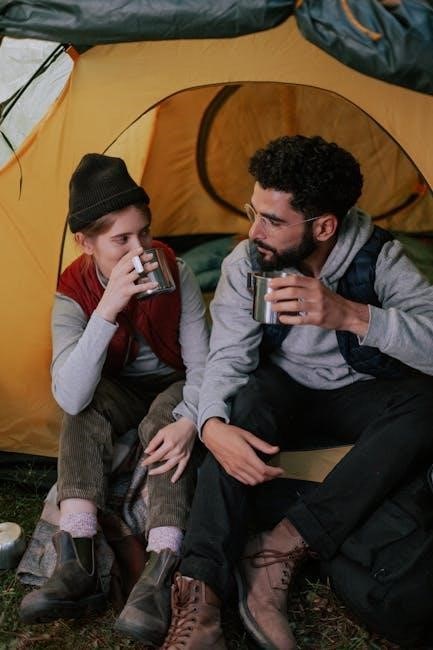
The 10 Essentials for hiking are a foundational set of items designed to ensure safety and preparedness in outdoor adventures․ Originating in the 1930s, they provide a framework for responding to emergencies and unexpected situations, promoting self-reliance and responsible exploration of nature․
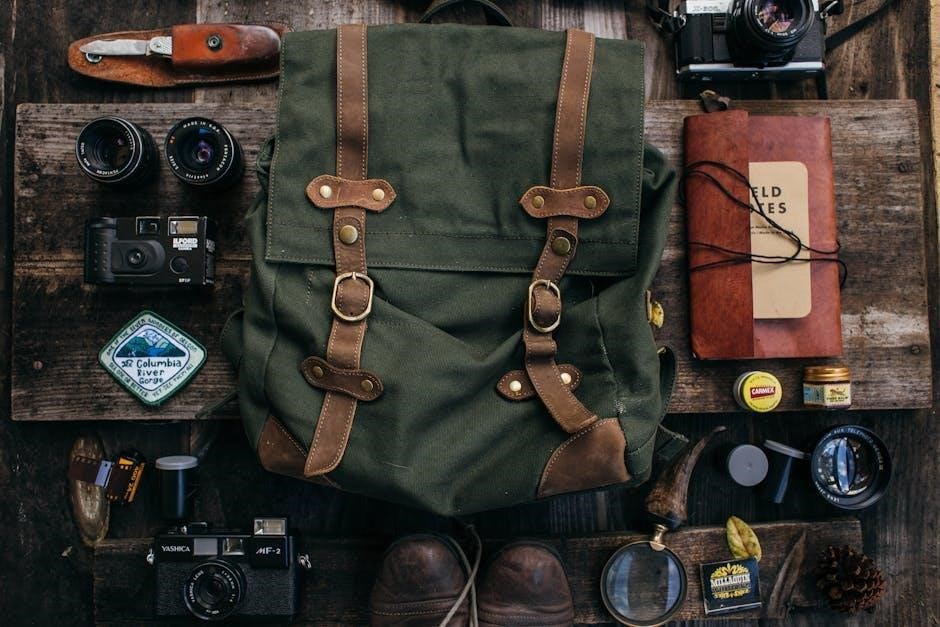
1․1 Historical Background
The concept of the 10 Essentials for hiking originated in the 1930s through the Mountaineers, a Seattle-based outdoor organization․ They developed this list to ensure climbers and hikers could respond effectively to emergencies․ Initially, the list included basic items like a map, compass, and first aid kit, reflecting the limited technology of the time․ These essentials were designed to help individuals survive unexpected situations and safely navigate the wilderness․ Over time, the list has evolved but remains a cornerstone of outdoor safety education and preparedness․
1․2 Evolution Over Time
Over the years, the 10 Essentials have adapted to technological advancements and changing outdoor needs․ Originally focusing on basic survival tools, the list now includes modern items like GPS devices, headlamps, and emergency shelters․ The integration of lightweight materials and multi-use tools reflects a shift toward efficiency and practicality․ These updates ensure the Essentials remain relevant, addressing contemporary challenges while maintaining their core purpose of enhancing safety and self-reliance in the wilderness․
Classic 10 Essentials
The Classic 10 Essentials are foundational items for hiking and outdoor adventures, ensuring safety and preparedness․ They include navigation tools, sun protection, insulation, illumination, first aid supplies, fire starters, a repair kit, nutrition, hydration, emergency shelter, and communication devices, providing a comprehensive system for survival and comfort in the wilderness․
2․1 Navigation Tools
Navigation tools are critical for staying on track and finding your way in the wilderness․ A detailed topographic map and a magnetic compass are essential, while GPS devices and altimeters add modern convenience․ These tools help hikers identify landmarks, track progress, and locate emergency exits․ Always carry extra batteries and know how to use traditional methods, as technology can fail․ Proficiency with navigation tools ensures confidence and safety, preventing situations like getting lost or disoriented․
2․2 Sun Protection
Sun protection is crucial for preventing sunburn, discomfort, and long-term skin damage․ Essential items include sunglasses with UV protection, sunscreen with SPF 30 or higher, a wide-brimmed hat, and protective clothing like long sleeves․ These items shield against harmful UV rays, especially at high altitudes or in reflective environments like snow or water․ Proper sun protection enhances hiking safety and overall enjoyment, preventing dehydration and heat-related issues․ Always apply sunscreen liberally and reapply as needed, even on cloudy days․
2․3 Insulation
Insulation is vital to maintain body heat in cold conditions․ A lightweight extra layer such as a fleece jacket or down vest is essential․ Bring a hat and gloves to prevent heat loss․ Consider a warm beanie for colder climates․ These items help prevent hypothermia, keeping you safe and comfortable during unexpected weather changes or delays․ Always pack insulation even on shorter hikes, as temperatures can drop rapidly, especially at higher elevations or in shaded areas․
2․4 Illumination
A reliable light source like a headlamp or flashlight is crucial for navigating in low-light conditions․ Pack extra batteries to ensure your light source doesn’t fail․ Illumination helps you find your way, set up camp, or signal for help if needed․ Even on day hikes, unexpected delays can lead to hiking in the dark, making a light source indispensable․ Always carry a backup light in case your primary one fails, ensuring safety and visibility in any situation․
2․5 First Aid Supplies
A well-stocked first aid kit is vital for treating minor injuries and preventing more serious conditions․ Essential items include bandages, antiseptic wipes, pain relievers, blister care, and medical tape․ These supplies help manage cuts, scrapes, sprains, and other common hiking injuries․ A first aid kit also includes tools like scissors and gloves for safe treatment․ Always customize your kit based on the length and difficulty of your hike, as well as any personal medical needs․ A proper first aid kit ensures you’re prepared to handle emergencies effectively․
2․6 Fire Starters
Fire starters are crucial for warmth, cooking, and signaling in emergencies․ Essentials include matches, lighters, or ferro rods, all stored in a waterproof container․ Modern options like firesteel or battery-and-steel combinations are also reliable․ Fire can boost morale, prevent hypothermia, and aid in food preparation․ Always carry multiple fire-starting methods to ensure reliability․ Practice using your tools beforehand to build confidence․ Fire starters are a simple yet vital component of your hiking safety kit, providing essential support in challenging situations․
2․7 Repair Kit and Tools
A repair kit and tools are vital for addressing gear failures and making field repairs․ Include a multi-tool or knife, duct tape, and a patch kit for torn fabric or inflatable gear․ Add a small sewing kit for repairing clothing or backpacks․ These tools enable you to fix broken zippers, secure loose parts, or reinforce weakened areas․ A repair kit helps prevent minor issues from escalating, ensuring your gear remains functional․ Keep it lightweight and versatile to cover a range of potential repairs during your hike․

2․8 Nutrition and Hydration
Nutrition and hydration are critical for maintaining energy and preventing dehydration․ Pack enough water for the duration of your hike, considering terrain and weather․ Include high-energy snacks like trail mix, nuts, or dried fruit to replenish calories․ Electrolytes or energy bars can help sustain stamina․ Always carry a reusable water bottle or hydration bladder, and consider a water filter or purification tablets as a backup․ Don’t forget to pack extra food in case of unexpected delays․ Proper nutrition and hydration ensure you stay energized and prepared for emergencies․

2․9 Emergency Shelter
Emergency shelter is a crucial item to carry, as it provides protection from harsh weather conditions like rain, wind, or cold․ A lightweight tent, tarp, or space blanket can serve as a temporary refuge․ These items are compact and easy to carry, ensuring you have a reliable option if stranded․ A small rope or paracord can also help secure your shelter․ Always prioritize durability and waterproofing to withstand unexpected weather․ Having emergency shelter can be a lifesaver, offering both safety and peace of mind during critical situations․
2․10 Communication Devices
Communication devices are vital for staying in touch with companions and seeking help in emergencies․ A cell phone is essential, but consider carrying a portable charger for extended trips․ For areas with no cell service, a two-way radio or satellite communicator like a GPS tracker ensures connectivity․ Whistles can signal for help when voice calls fail․ These tools enhance safety by enabling quick communication during crises, ensuring you can call for assistance or coordinate with your group effectively in remote locations․
Importance and Benefits
The 10 Essentials enhance safety, preparedness, and confidence during outdoor adventures, ensuring hikers can respond to challenges and stay protected in diverse and unpredictable environments․
3․1 Enhancing Safety
Carrying the 10 Essentials significantly enhances safety by providing tools to navigate, protect against elements, and respond to emergencies․ Items like maps, headlamps, and first aid kits ensure preparedness for unexpected situations, while sun protection and insulation guard against environmental risks․ These essentials empower hikers to address challenges effectively, reducing the likelihood of accidents and enabling safe exploration․
3․2 Preparing for Emergencies
The 10 Essentials are vital for emergency preparedness, ensuring hikers can respond effectively to unexpected challenges․ Items like emergency shelters, first aid kits, and communication devices provide critical support during injuries, weather changes, or getting lost․ Fire starters and repair kits also aid in sustaining safety and comfort․ By carrying these essentials, hikers are better equipped to handle unforeseen situations, minimizing risks and ensuring a safer outdoor experience․
3․4 Promoting Self-Reliance

The 10 Essentials empower hikers to become self-reliant by providing the tools necessary to address challenges independently․ Carrying these items fosters confidence and readiness, allowing individuals to navigate, treat injuries, and adapt to changing conditions without external assistance․ This self-sufficiency enhances the hiking experience, encouraging personal growth and a deeper connection with nature․ By mastering the use of these essentials, hikers develop critical skills that contribute to a safer and more fulfilling outdoor adventure․

Modern Interpretations
Modern interpretations of the 10 Essentials integrate technological advancements and environmental awareness․ They emphasize lightweight, durable gear and sustainable practices, ensuring preparedness while minimizing ecological impact;
4․1 Technological Advances
Technological advancements have revolutionized the 10 Essentials, introducing GPS devices, altimeters, and satellite communicators․ These tools enhance navigation accuracy and emergency response capabilities․ Modern headlamps offer brighter, energy-efficient lighting, while solar chargers and power banks keep devices powered; Additionally, apps like Gaia GPS provide real-time trail data, and wearable technology monitors vital signs, improving safety․ These innovations ensure hikers are better equipped to handle challenges while maintaining the core principles of preparedness and self-reliance in the wilderness․
4․2 Environmental Considerations
Environmental considerations emphasize sustainable practices within the 10 Essentials framework․ Hikers are encouraged to adopt eco-friendly habits, such as carrying reusable containers to minimize waste and using biodegradable toiletries․ Lightweight, durable gear reduces the need for frequent replacements, lowering environmental impact․ Additionally, choosing products with minimal packaging and avoiding single-use plastics aligns with conservation goals․ By integrating these practices, hikers can enjoy nature responsibly while maintaining safety and preparedness, ensuring that their outdoor adventures leave a minimal footprint on the environment․
How to Choose the Right Gear
Selecting the right gear involves balancing quality, durability, and personal needs․ Prioritize items that align with your hiking plans, ensuring reliability and suitability for varying conditions․
5․1 Assessing Quality and Durability
Assessing the quality and durability of hiking gear is crucial for reliability in the field․ Look for items made from weather-resistant, high-performance materials that can withstand harsh conditions․ Durability often correlates with weight and cost, so balance these factors based on your needs․ Prioritize gear with a proven track record, such as products from reputable brands․ Additionally, consider warranties and user reviews to gauge long-term performance․ While more expensive options may offer greater durability, they aren’t always necessary for every hiker․ Evaluate how each item aligns with your specific hiking plans and requirements․
5;2 Considering Personal Needs
When selecting gear for the 10 Essentials, it’s important to tailor choices to your personal needs, hike duration, and terrain․ Consider factors like weather conditions, physical ability, and group size․ For instance, longer hikes may require more hydration and nutrition, while rugged terrain demands sturdier footwear․ Additionally, personal health conditions may necessitate specific first aid items․ Always evaluate your unique requirements to ensure your gear matches the demands of your adventure, enhancing both safety and comfort on the trail․
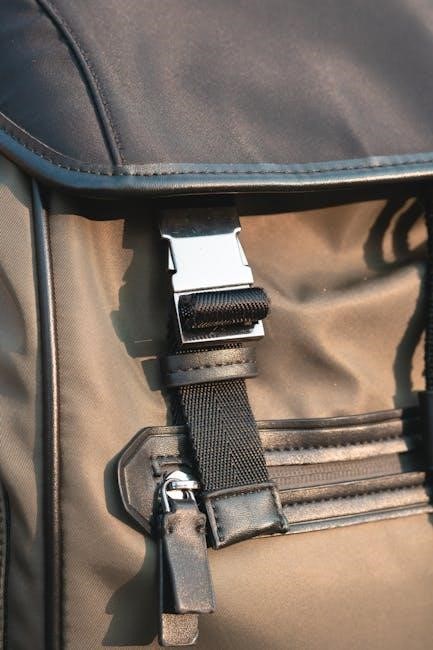
Real-Life Scenarios
The 10 Essentials have proven critical in real-life hiking scenarios, such as navigating unexpected weather changes, treating injuries, or finding shelter during prolonged delays, ensuring safety and survival․
6․1 Case Studies
Case studies highlight the importance of the 10 Essentials in real-life hiking situations․ For example, a hiker lost in dense fog used a map and compass to navigate safely back to camp․ Another case involved a group caught in a sudden snowstorm, where extra clothing and a portable shelter saved them from hypothermia․ These examples demonstrate how preparedness with the 10 Essentials can prevent minor setbacks from turning into life-threatening emergencies․
6․2 Lessons Learned

Lessons learned from hiking experiences emphasize the critical role of the 10 Essentials․ Many hikers have discovered that carrying a map and compass, even with a GPS, is vital for navigation in areas with no signal․ Extra clothing and emergency shelters have proven indispensable in unexpected weather conditions․ Additionally, a first aid kit and headlamp have saved hikers from worsening injuries and navigating in the dark․ These lessons underscore the importance of being prepared and adaptable, ensuring safer and more enjoyable outdoor adventures․
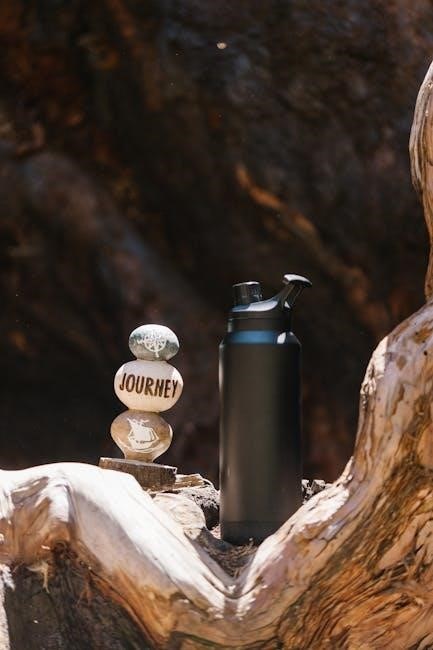
Packing Tips
Packing efficiently involves organizing the 10 Essentials systematically․ Use a backpack with compartments to keep items accessible․ Roll clothing to save space, and place heavy items near the back․ Ensure water, snacks, and a first aid kit are easily reachable․ Distribute weight evenly and secure loose items to prevent shifting․ This approach maximizes comfort and accessibility, ensuring a more enjoyable hiking experience․
7․1 Efficient Packing
Packing efficiently ensures a comfortable and enjoyable hiking experience․ Start by organizing the 10 Essentials into categories, such as navigation, first aid, and shelter․ Use a backpack with multiple compartments to keep items accessible and visible․ Roll clothing to save space and reduce wrinkles․ Place heavier items, like water and snacks, near the bottom for better weight distribution․ Secure loose items with clips or straps to prevent shifting․ Consider using compression bags for bulky gear like extra layers․ This method keeps everything tidy and within reach, making your hike more efficient and stress-free․
7․2 Maintaining Accessibility
Maintaining accessibility ensures that critical gear remains within easy reach during your hike․ Store the 10 Essentials in designated pockets or compartments of your backpack for quick retrieval․ Place frequently used items, such as snacks and maps, in easily accessible areas․ Avoid overloading compartments, as this can hinder access․ Use clips, straps, or carabiners to secure items like water bottles or headlamps․ Regularly check that zippers and buckles are functioning properly․ This approach allows you to efficiently locate and use your gear when needed, enhancing both safety and convenience on the trail․
The 10 Essentials are crucial for a safe hiking experience, ensuring preparedness for emergencies․ Prioritize these items to enhance safety and enjoyment in the wilderness․
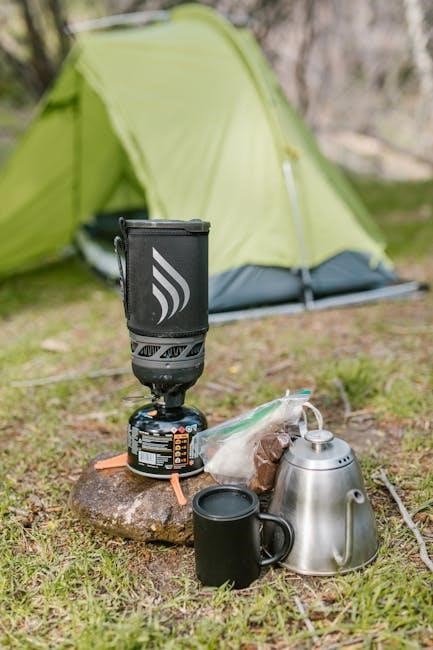
8․1 Final Thoughts
The 10 Essentials for hiking are a timeless framework for safety and preparedness in the outdoors․ They emphasize the importance of being self-reliant and adaptable, ensuring hikers can respond to emergencies and unexpected challenges․ While the list has evolved over time, its core principles remain vital for any adventure․ By carrying these essentials, hikers can minimize risks and maximize enjoyment, whether on a day hike or an extended wilderness expedition․ Remember, preparedness is key to a safe and rewarding outdoor experience․
8․2 Encouragement to Prepare
Preparedness is the cornerstone of a safe and enjoyable hiking experience․ The 10 Essentials serve as a vital reminder to always be ready for the unexpected․ By carrying these items, hikers can transform potential disasters into manageable situations․ Remember, the list is a guide, not a guarantee, and it’s up to each individual to adapt it to their unique needs․ Take the time to pack thoughtfully, stay informed, and embrace the mindset of self-reliance․ Your preparation today ensures confidence and safety on the trail tomorrow․